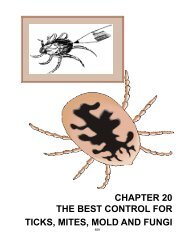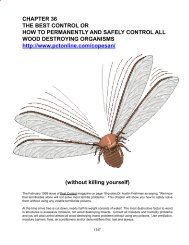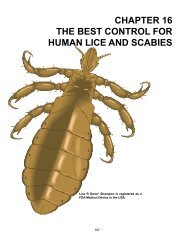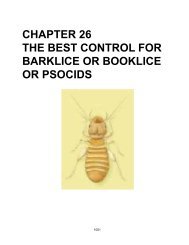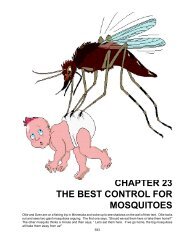Planting Times and Spacing - can be used to environmentally control and/or prevent insect pests.Plants - Garlic, spurge, tansy, pennyroyal, eucalyptus, peppermint, yarrow, wormwood, southern wood, lavender,sage, marigolds, scented geraniums, fritillaria, etc. are all known to have animal and/or insect-repelling qualitiesand have been used in companion planting or by themselves to control pests.Plastic Sheeting (Black) - Covering the soil surface under the hot sun will sterilize the soil and kill plantsindiscriminately.Plowing - Simple plowing helps control many kinds of weeds, diseases, insects and other pests.Poison Ivy - If you know you just brushed up against poison ivy and can get to cold water within three minutes,wash away the nasty stuff. But don’t use soap - it may seal in the poison-ivy oil. If the three-minute clean-upwindow is over and the itching is unbearable, reach for some Not Nice to Skin Irritations ® or a slice of watermelon.Eat or cut off most of the fruit, leaving about a half-inch on the rind. Rub the rind over your rash-ridden bodyparts. Let dry naturally. Or you can try plaintain balm; juice 1 c. plaintain leaves in a blender or food processorwith 3 - 4 c. water to make a slurry; then dab it on the affected areas. Dilute 1 part of the slurry with 3 parts wateror apple juice and drink it. <strong>The</strong> leaves of the plaintain can be used internally and externally to draw out toxins.You can also freeze the slurry/juice in an ice cube tray for emergencies. Add the slurry to a warm bath and soakfor ½ hour. Place the juice on any remaining problem areas. You can also use the juice of a jewelweed stemto alleviate poison ivy. Once again, you can take a pot of jewelweed stems, leaves and flowers and cover withwater; simmer for 30 minutes; then freeze into cubes. You can use the cubes directly on the skin to relieve poisonivy, stinging nettle and/or insect bites. You should be considerably better the next day; if not, see a doctor.Poisonous Plants - Four - o’clocks, Jimson-weed (Datura stramonium) dwarf and red buckeyes and delphiniumsattract and kill pests like Japanese Beetles, but they are toxic to humans and pets as well.Polaroid Glases - Allow you to see into the water and in white-out snow conditionsPolice Tape - “Do not cross” tapes can be used to keep most people out of an area; they do not work on childrenor pets.Polycultures - Nematodes, weeds, insect pests and diseases are generally less abundant in polycultures thanmonocultures. Even if some plants die, they all will not die. Plant a variety of crops with different growth habits.Polyethylene Terepthalate Sheets - Sheets of this material and other plastic surfaces can be used to preventbeetle larvae, e.g., lesser mealworm and hide beetle larvae, from climbing. <strong>The</strong>se barriers can be used to preventpassage of emerging beetle larvae.Polymers - have been used for years in aquatic pest control, primarily for drift control because of their longchaincarbon molecules (up to 40,000 per polymer strand). Polymers like nitrile which kills cells by continuallyreleasing a toxic substance into the culture medium. <strong>The</strong> toxicity of polyurethane varies considerably due to themanufacturing process. <strong>The</strong>re has been research on the emission of toxic sulfur gases from polymers comingin contact with food products and infants, so “we” stopped all further research on polymers early in 1998.Polypropylene Bird Netting - will keep birds out of fruit trees and many other areas. Span bat entry wayswith netting (several feet on each side) and allow the netting to taper and hang down at least 3 feet below theopening(s); using staples and duct tape secure the tops and sides (be sure to taper the sides) of the netting tothe building. Be sure to leave an (unfastened) opening no more than 15” wide at the bottom. After several daysthe bats will leave and you can permanently seal all of the openings.Polysorbate 80 - is a nonionic surfactant and emulsifier and dispersant that is relatively inert and is readilyabsorbed by the skin, it is derived from sorbitol, which comes from fruit and berries used as a dispersing agent- mixes oil and water, stabilizer and lubricates. Polysorbate 80 is known to increase the absorption of drugs,vaccines, mineral oils and other fat soluble materials. Personal note: You may want to compare the effectivenessof glyceryl cocoate, which is derived from coconuts.444
Pomander - Repel moths and other insects with a clove petard by studding an orange, apple, lemon, lime orkumquat with the aromatic buds from the evergreen clove tree, then place it in cupboards, drawers and closets.Population Prevention - One female aphid can produce 6 billion in one summer. One female flea can lay 5,000eggs in her lifetime. One female tick can lay 7,000 eggs at a time. One female fruit fly can lay 800 eggs in herlifetime. Early reduction of even one pregnant female pest can substantially effect future population densities.Potassium bicarbonate - 1 T. mixed in 1 gal. water controls fungal diseases like black spot and powdery mildew.Potato - Trap wire worms which are the larvae of click beetles by scooping out several small holes in the gardensoil. Toss in sliced potato and cover with boards - the “nests” will attract wireworms - collect the infested potatoesevery other day and drop them into soapy water to kill the pests safely.Potato Starch Spray - Mix 2 T. - 4 T. of potato flour and a dash of liquid soap in 1 qt. water to safely contrtolfungal diseases and insects.Potato Water - Concentrations of potato water have been rubbed on cattle, and clove on chickens and dogsto repel lice.Power Dusters - impart an electrical charge to talcum powder, food-grade DE, boric acid, humates or any dust,making them excellent pest control devices.Powdered (Non-fat dry) Milk - Lightly sprinkle on tomato plants and on the ground directly underneath toprevent many diseases.Powdered Sugar - Dusted on wet cabbages will repel worms.Power Washers - are tremendous tools, especially when used with Safe Solutions Tweetmint Enzyme Cleaners- do not use cleaners that contain active bacteria or unknown quantities of protease enzymes. Follow the label.Prayer - Prayer changes things.Praying Mantids - should be called preying mantids because they will eat just about any insect including eachother.Predator Urine - will repel many herbivores and come carnivores. A drop or two of fox urine (on a cotton ball)will often cause raccoons and squirrels to vacate your attic space.Predators and Parasites - Without these beneficial insects (the most populous form of life on this planet)nothing man could possibly do would stop the pests from taking over this planet. At least 65% of all pests arecontrolled by other insects.Predatory Arthropods - Linneaus wrote about controlling pest problems using predatory arthropods in 1752.Insects have been controlled since the beginning of time by other insects, arachnids and/or diseases of insects.See Spiders.Predatory Mites - can be used to control pest mites.Preformed Enzyme Cleaners - or salmonella-free enzyme cleaners are what we previously recommended beused as an all-around cleaner, insectisafe and fungisafe or Pestisafes ® ; now we only recommend Safe Solutions,Tweetmint Enzyme Cleaner is used at 1 oz. per quart to control pests and 1 oz. - 2 oz. per 3 gallons of water toclean and/or flood ant colonies - you may add a “kicker” of a teaspoon of vegetable or canola oil, a tablespoonof borax, ½ of a grated lime, a few drops of liquid soap or garlic oil, 1 teaspoon of alcohol or hydrogen peroxide,a few drops of glycerin per quart of mix for quicker or better control of virtually all insects, fungus, mold and/ormildew. Unlike volatile, synthetic pesticide poisons, you can adjust the enzyme (pest-killing) application rate. A1 to 500 ratio kills garden, lawn, orchard, grove and field pests, e.g., mites, aphids, leaf miners, etc. but leaves(harder-bodied) biological/beneficials, e.g., ladybugs and Aschersonia, a beneficial fungus (that destroy white445
- Page 1:
CHAPTER 11SAFE AND FAR MOREEFFECTIV
- Page 4 and 5:
pesticide poisons do - to them the
- Page 6 and 7:
American Beautyberry (Callicarpa am
- Page 8 and 9:
packets in 4 days or less. Aspartam
- Page 10 and 11:
Baking Soda - Baking soda or sodium
- Page 13 and 14:
Bioderivatives - are substances whi
- Page 15 and 16:
Bird feeders - will attract more th
- Page 17 and 18:
an abrasive action on the insect wh
- Page 19 and 20:
pathogens - volatiles produced duri
- Page 21 and 22:
ground, grain and stored product ap
- Page 23 and 24:
epels many insects, including flies
- Page 25 and 26:
een used medically since at least t
- Page 27 and 28:
Collateral Damage - When you spray
- Page 29 and 30:
Cottonseed Meal - is a source of ni
- Page 31 and 32:
Desiccants - Hot air, dehumidifiers
- Page 33 and 34:
Dogs - have been trained to sniff o
- Page 35 and 36:
elderberry leaves to protect them f
- Page 37 and 38:
controls pests and acts as a deodor
- Page 39 and 40:
contamination that no one can hones
- Page 41 and 42:
Chlorphyll Graphite Parrafin wax Wa
- Page 43 and 44: Film Capsule - The plastic capsule
- Page 45 and 46: Repel roaches with bay leaves and e
- Page 47 and 48: person in your house, but you’ll
- Page 49 and 50: slender sickle-shaped jaws. They ap
- Page 51 and 52: epellent that contains only natural
- Page 53 and 54: infusion of pignut leaves, rubbed o
- Page 55 and 56: Human Hair - cut in small pieces wi
- Page 57 and 58: Insect Diseases - In 1836, Agostino
- Page 59 and 60: Irrigation Management - Improper ir
- Page 61 and 62: lack cutworms.Laxatives - Chocolate
- Page 63 and 64: we die. Check out magnesium in Chap
- Page 65 and 66: Milk Thistle - is a proven detoxifi
- Page 67 and 68: Moon Flower (Datura ioxia) - Do not
- Page 69 and 70: Spotted knapweed begins producing c
- Page 71 and 72: Nothing - Doing nothing is a choice
- Page 73 and 74: fertilizers and sprays will normall
- Page 75 and 76: added to enzyme cleaners or when us
- Page 77 and 78: yellow to yellow crystalline solid
- Page 79 and 80: Aureolaria virginica (L.) Pennell.
- Page 81 and 82: Clematis vitalba L. (Honduras fish
- Page 83 and 84: Euphorbia bicolor Engelm. and Gray.
- Page 85 and 86: Justicia adhatoda L. (Adhatoda vasi
- Page 87 and 88: Momordica charantis L. (Balsam-pear
- Page 89 and 90: Piper nigrum L. (Black pepper).Stro
- Page 91 and 92: Sesamum indicum L. (S. orientale L.
- Page 93: Xanthorrhoea hastilis R. Br. (Black
- Page 97 and 98: y Safe Solutions at 1-888-443-8738
- Page 99 and 100: ight red and cover them with petrol
- Page 101 and 102: a wide variety of antioxidants call
- Page 103 and 104: Sawdust - Sawdust can be treated wi
- Page 105 and 106: lit charcoal in the tunnels would a
- Page 107 and 108: Active IngredientGeneric Name Trade
- Page 109 and 110: Sour Milk - sprays will loosen scal
- Page 111 and 112: Stay Calm - Take a deep breath amd
- Page 113 and 114: to make the mix about the consisten
- Page 115 and 116: pesticides have never controlled or
- Page 117: Temperature - Increase or lower tem
- Page 120 and 121: in colder climates. The most fragra
- Page 122 and 123: and/or dehumidifiers, plumbing and
- Page 124 and 125: odents, scorpions, etc. to your bai
- Page 126 and 127: Oregano also contains four anti-ast
- Page 128 and 129: like colds, and headaches and spend
- Page 130 and 131: then estimated human population. Gi
- Page 132 and 133: “The choice, after all, is ours t
- Page 134: 484



